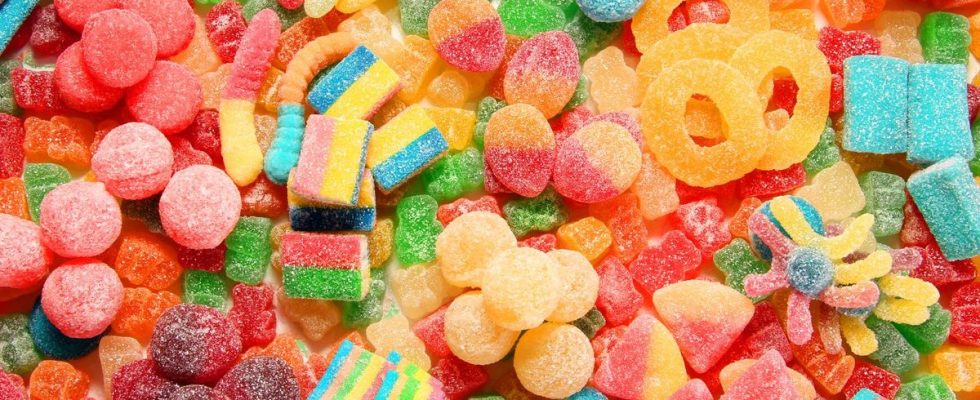Fifty years later Winner Mistral by Renaud, let us also take the time to “sit for five minutes on a bench” and recount the nostalgia of the taste of the sweets of our childhood. Let us reassure ourselves, the tenderness of nineties on which we broke our baby teeth so much – Carambar, Tagada strawberries, Chupa Chups, fried eggs and smurfs – is still present. But their taste, simply mild and sweet, seems a little dated in the face of the new trend: spiciness.
The power now belongs to sour, citric, spicy candies… Call them what you want, those that tear the mouth apart and transform the sweetness of yesteryear into an inferno on the tongue. Beyond the new stars, like the now essential Hotheads, even the glories of yesteryear – yes, the Haribo crocodiles, we’re thinking of you – have given in to the hype and are offering their “qui pik” version . Yes, the one with this famous tangy white powder omnipresent in the confectionery aisle.
Spicy, the number one confectionery segment
Thimothé Luvungo, consultant at Nielsen, confirms that “sour gummies”, as they are listed by the research firm, are now the leading segment of sweet confectionery in terms of sales by value, with incredible growth. In 2020, the French spent 130.8 million euros on sour candies. Count 150 million in 2021, or + 14.7%. And 176.1 million in 2022, another +17.4%. Again in 2023, the expert notes “a stronger development in sour candies than in the rest of the confectioneries. These candies outperform, with growth whose value is on average one point higher than that of the rest of the market.
Same analysis by Virginie Orezzi, Marketing Director of Haribo France. At the German giant, acid represents “the segment that sells the most”, accounting for a fifth of sales. A stranglehold that is not about to end, since the segment “also has the strongest growth. 20% of our total growth is due to spiciness. »
2010, the pivotal decade and the Haribo offensive
The trend is therefore there, but is not so new. And 2011 can be seen as a turning point for sour candy, like 1971 for rock ‘n’ roll. In a children’s confectionery market up 4.9% over twelve months, acid soars to + 13.3%, again according to Nielsen. Above all, the number of products is exploding. That year, Chupa Chups launched “Mini Chupa Chups Kipik”, while Haribo began what would become its spearhead: the “Pik” range contains only tangy products, including some revisited great classics. At the time, only Croco Pik and Smurf Pik stuck to it, before others followed suit over the years. Acid, which only existed in two ranges in the 1990s (coke and fries), has continued to multiply ever since.
“We smelled a candy with potential, and we were late in the sector. We had to make up for it,” argues Virginie Orezzi. In 2009, Haribo only accounted for 9% of sour candies in France. The group now accounts for 39% of the sector, and 85 sour candies from the brand are eaten every second in France. While we’re at it, the decade also corresponds to the explosion of Hotheads. With a well-established advertising campaign and a reinforced presence in bakeries and mass retailers, their sales increased 40-fold between 2013 and 2015.
“A rite of passage into adolescence”
Spicy, “it’s a very sought-after and very popular taste,” confirms Elisabeth Tissier-Desbordes, professor of economics at ESCP and specialist in consumer behavior. For children, “there is this mixture of fear and desire for the unknown and for what looks like an adult. Acid and spiciness are tastes that make you feel “bigger”. » Caroline Champion, independent flavor researcher, even evokes “a rite of passage into adolescence. There is the feeling of being a grown-up when you are able to swallow tastes that explode in your mouth. This discomfort proves something to us. »
Child, adolescent and also… adult. “It’s a taste that can appeal to all ages, depending on the degree of acid, which explains its success,” notes Clémentine Hugol-Gential, professor and specialist in contemporary food issues at the University of Burgundy. Especially since by revisiting classics, brands manage to strike the nostalgic chord of adults by offering them a less childish taste. “These are historic and at the same time innovative products,” praises Virginie Orezzi. This allows Haribo to ride on tradition and show its modernity. » And the brand does not intend to stop there: it has planned the launch of several new “qui pik” products for the 2023-2024 season.
The ultimate candy?
Sour candy is also a response “to the playful side that food must now take on to seduce,” continues Clémentine Hugol-Gential. And it is ultra-fun: it has different flavors, provokes different sensations, allows you to experiment. »
Moreover, speaking of trends, Caroline Champion sees in this success “a general provocation to the trend of all organic, all plant-based, all natural. Faced with this, the role of candy is to be absolutely useless in nutritional terms and totally unnatural. » This is why he often wore strange, fluorescent colors, a fake and plastic appearance. “We would never want to eat a blue steak for example, whereas a candy can approach this color.”
As such, spiciness would be the ultimate snub. Acid rather than healthy. Until indigestion? Vincent Bruart, marketing director of the famous Têtes Brûlées, recognized in our columns last year that too much could be the enemy of good. “The taste was more and more acidic, therefore more and more segmenting. We put a little bit of everything and anything as long as it was fun,” he regretted. Enough to make us definitely nostalgic for our good old sweets from the 1990s.

